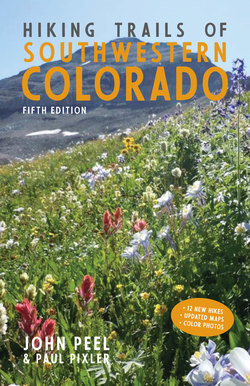Читать книгу Hiking Trails of Southwestern Colorado, Fifth Edition - John Peel - Страница 8
ОглавлениеPointing to a ridge that I’m not going to attempt between Wetterhorn and Matterhorn. (Photo by Steve Chapman)
Here I am hard at work atop US Grant Peak. (Photo by Peter Schertz)
TECHNOLOGY
In this day and age, I guess I would find this situation embarrassing: I’m lost or injured in the woods and have no phone even though I’m in cell range. Or I have a phone with cell coverage but can’t tell anyone where I am because I don’t know.
Of course, technology is continually changing even as I write this book, and I can actually be kind of a Luddite, but I’d be remiss if I didn’t point out the ways that electronic devices can enhance your hike and help get you out of trouble. GPS (Global Positioning System) devices and phone apps are helpful methods of measuring and plotting your route, and communicating with others. Use your devices to your best advantage, but it’s important to understand their limitations too.
Here’s a brief description of some of the technology and apps out there.
GPS UNITS
To figure out where you are, this is still the best method. GPS is a method of triangulating your position on the planet using satellites hovering 12,000-plus miles above the Earth. Your GPS unit can determine within a few feet where you stand. If your GPS unit also has a downloaded map, then you’re set for navigating. Even if it doesn’t, you can still use it to get back to where you were—a previously tracked trail or waypoint, for instance. It’s very handy.
Garmin dominates the GPS market, but there are other brands.
YOUR SMARTPHONE
With your Android, iPhone, or other smartphone, you can download several apps to help you navigate around the planet.
For hiking, GaiaGPS currently seems to be the go-to app. You can use the free version, or pay about $20 a year to download maps and have access to other helpful perks. Gaia acts much like a GPS unit. It tells you where you are and records your track so you can look at all the stats later and relive the hike, if that’s what you’re into. It’s fun and informative. Strava is another app that uses GPS to determine your place and track your progress. It’s a popular one among cyclists and runners, but there’s no reason hikers can’t use it.
To figure out what peaks you’re seeing on the horizon, there’s PeakFinder AR or PeakVisor, among others. Both of these work offline.
There are also apps for learning knots (Animated Knots by Grog), identifying flowers (iNaturalist), and showing the nearest spot where you can get cell phone reception (Cairn). It doesn’t end there.
PERSONAL LOCATOR BEACON
This was also mentioned in the Introduction. These walkie-talkie–sized devices use satellites and will work to send out an emergency message where cell phones may not. The personal locator beacon (PLB) sends an SOS and your location to rescue agencies. PLBs have the capability to work around the world.
Satellite messengers are a step up from PLBs. These send distress signals and allow the user to send texts and have two-way communication. The more information rescuers have, the better off they and you will be. These aren’t cheap. As mentioned above, the base price is about $350, and with satellite messengers you also need to be on a subscription plan, so that adds another expense.
There are many options with PLBs and satellite messengers, and the technology is expanding rapidly, so research your options to see what’s current and to understand whether you truly need this.
